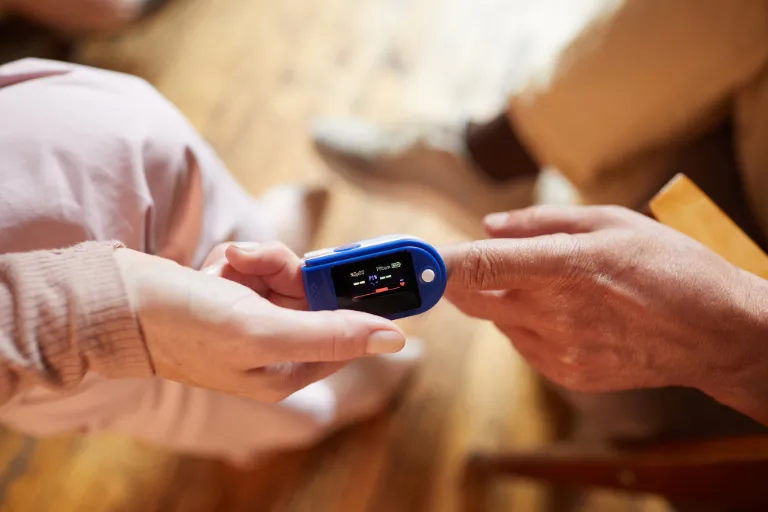Key Points
- Blood oxygen naturally shifts with age, often dropping slightly in older adults.
- Low oxygen can affect heart health, lung function, and cognitive well-being.
- Warning signs include fatigue, dizziness, rapid heartbeat, and brain fog.
- At-home monitoring tools like pulse oximeters can help track oxygen levels.
- Lifestyle strategies—such as exercise, breathing practices, and sleep—support healthy oxygen levels.
Why Seniors Should Pay Attention to Oxygen Levels
Imagine walking up a flight of stairs. For many younger adults, it’s a simple, almost mindless activity. But for seniors, the same effort can trigger shortness of breath, lightheadedness, or fatigue. These sensations are often linked to oxygen levels in the blood—a silent marker of health that becomes increasingly important with age.
Oxygen isn’t just about breathing; it’s about sustaining the body’s most vital functions. Even small dips in oxygen levels can affect the heart, brain, and energy reserves in noticeable ways. As life expectancy increases, understanding these subtle but powerful shifts can make the difference between thriving in later years and struggling with preventable symptoms.
Why Oxygen Monitoring Matters for Senior Health
Oxygen fuels every cell in the body. Yet, as we age, natural changes in the lungs, heart, and blood vessels can reduce the body’s efficiency at delivering it [1]. Seniors are particularly vulnerable to dips in oxygen saturation, which can affect daily energy, mobility, and even independence.
Monitoring oxygen isn’t just for those with diagnosed lung or heart problems. Even healthy older adults can benefit from understanding how their levels change over time [2]. Unchecked, low oxygen saturation may contribute to chronic tiredness, heart palpitations, sleep problems, and reduced cognitive performance [3].
Recognizing Warning Signs of Low Oxygen Saturation in Seniors
Blood oxygen saturation (SpO₂) refers to the percentage of oxygen-carrying hemoglobin in the blood. For most adults, normal levels range between 95% and 100%. In seniors, levels may naturally sit a little lower, sometimes around 92–95% [4].
Warning signs of low oxygen may include:
- Persistent fatigue, even after rest
- Dizziness or lightheadedness
- Rapid heartbeat during light activity
- Shortness of breath, especially with exertion
- Brain fog, forgetfulness, or slowed thinking
These signs can sometimes be dismissed as “just aging,” but they may also indicate oxygen delivery issues that need professional attention [5].
The Physiology of Aging: How the Body’s Oxygen System Changes
Several physiological changes contribute to declining oxygen efficiency in senior years:
- Lung Function Decline: Aging lungs lose elasticity, making it harder to expand fully during breathing. This reduces oxygen exchange [6].
- Circulatory Shifts: Blood vessels stiffen, and the heart pumps less efficiently, limiting oxygen transport to muscles and organs [7].
- Respiratory Muscle Weakness: The diaphragm and chest muscles may weaken, making deep breaths harder to sustain.
Research shows that these shifts can contribute to reduced physical stamina, slower recovery from illness, and increased risk for cognitive decline. For example, chronic low oxygen has been linked to memory lapses and depressive states in older adults [8].
Practical Strategies to Maintain Healthy Oxygen Levels in Seniors
The good news is that many strategies can help seniors maintain better oxygenation:
- Stay Active: Regular walking, light strength training, or tailored exercises can improve lung and heart efficiency [2].
- Breathing Practices: Techniques such as pursed-lip breathing and guided breathing exercises help maximize oxygen intake.
- Prioritize Sleep: Quality rest supports steady breathing patterns and oxygen balance overnight.
- Optimize Home Environments: Good ventilation and reducing indoor pollutants (like smoke or dust) can make a big difference.
- At-Home Monitoring: Devices like pulse oximeters provide quick readings. While not perfect, they offer a useful snapshot of trends. Seniors should check levels during both rest and activity [4].
When levels repeatedly drop below 92%, or when symptoms like dizziness or heart palpitations occur, it’s important to consult a health professional [5]. Some may recommend further tests, supplemental oxygen, or structured therapies such as pulmonary rehabilitation.
When to Seek Professional Guidance
For seniors and caregivers, the first step is awareness. Tracking how oxygen levels behave at rest, during exercise, and while sleeping can reveal important patterns. If concerning dips are noticed, a health professional can help determine whether interventions—from simple lifestyle changes to medical solutions—are necessary [7].
Caregivers can also play a role by ensuring home environments are supportive, encouraging safe exercise, and watching for signs of rapid heartbeat, chronic tiredness, or unexplained confusion. Early intervention can prevent complications and support independence.
Conclusion: Breathing Easier with Age
Oxygen levels may not be the first thing most people think about when it comes to aging. Yet, they influence nearly every aspect of health—from stamina and heart rhythm to memory and mood. By paying attention to how oxygen changes with age, seniors and caregivers can take simple but powerful steps toward protecting long-term well-being.
The article does not in any way constitute as medical advice. Please seek consultation with a licensed medical professional before starting any treatment. This website may receive commissions from the links or products mentioned in this article.
Subscribe for Free for more insightful health articles tailored to your needs.
Sources
- American Lung Association. (2023). How Lungs Change with Age. https://www.lung.org
- National Institute on Aging. (2022). Respiratory Health in Older Adults. https://www.nia.nih.gov
- Harvard Health Publishing. (2021). Low oxygen levels and your health. https://www.health.harvard.edu
- Cleveland Clinic. (2023). Pulse Oximeter Readings: What’s Normal? https://my.clevelandclinic.org
- Mayo Clinic. (2023). Hypoxemia: Symptoms and causes. https://www.mayoclinic.org
- Janssens, J.-P., & Pache, J.-C. (2019). Aging and the respiratory system. Respiratory Medicine, 150, 1–7. https://doi.org/10.1016/j.rmed.2019.01.001
- North, B. J., & Sinclair, D. A. (2012). The intersection between aging and cardiovascular disease. Circulation Research, 110(8), 1097–1108. https://doi.org/10.1161/CIRCRESAHA.111.246876
- Yaffe, K., et al. (2011). Sleep-disordered breathing, hypoxia, and risk of mild cognitive impairment and dementia in older women. JAMA, 306(6), 613–619. https://doi.org/10.1001/jama.2011.1115




